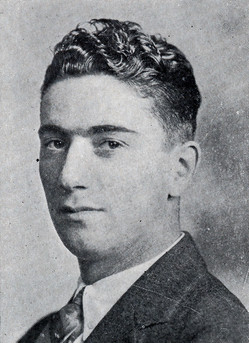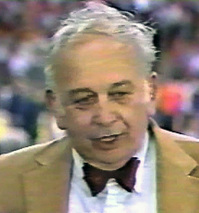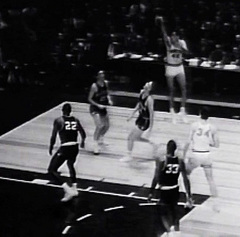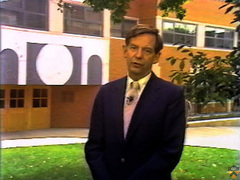 Primarily known as a Major League catcher and coach, Morris “Moe” Berg was also a spy for the Office of Strategic Services (OSS) in World War II, as well as a lawyer, linguist, and Princeton graduate. As a member of the class of 1923, Berg excelled scholastically and athletically by graduating with honors in Modern Languages (he studied Greek, French, Spanish, Italian, German, and Sanskirt), and playing first base and shortstop for the Princeton Tigers. While his batting average was low- Berg inspired a Major League scout to utter the phrase, “Good field, no hit”- he was known at Princeton for his strong arm and sound baseball instincts.[i]
Primarily known as a Major League catcher and coach, Morris “Moe” Berg was also a spy for the Office of Strategic Services (OSS) in World War II, as well as a lawyer, linguist, and Princeton graduate. As a member of the class of 1923, Berg excelled scholastically and athletically by graduating with honors in Modern Languages (he studied Greek, French, Spanish, Italian, German, and Sanskirt), and playing first base and shortstop for the Princeton Tigers. While his batting average was low- Berg inspired a Major League scout to utter the phrase, “Good field, no hit”- he was known at Princeton for his strong arm and sound baseball instincts.[i]
Author Archives: Mudd Manuscript Library
Reunions, reunions, 1915-2009
Princeton’s reunions are almost as old as Princeton University itself, going back to the days when the university was still known as the "College of New Jersey." In today’s blog, posted during the Reunions weekend of 2011, we are showing you the oldest reunion footage in the University Archives: an annotated film of the Class of 1895’s 20th and 30th Reunions in 1915 and 1925, followed by footage of the Class of 1915’s 40th Reunion in 1955, and the Class of 1944’s 65th Reunion in 2009, the most recent reunion footage in the University Archives. The films may be compared with reunion footage featured in previous blogs, including the Reunion of the Class of 1921 in 1923 and 1926, and the Reunions and P-rade of 1928, of 1960 and 1961, and of 1986. A compilation of this footage to welcome returning alumni in 2011 can be found here.
The Class of 1895’s 20th reunion footage is the first of its kind, and would well have been the very oldest film in the University Archives, if not for the newsreel footage of the inauguration of President John Grier Hibben in 1912. The film was made by the Connecticut Film Company, which had two men follow the class around campus on Reunions Saturday, then return the following Monday to show the film at the Class Dinner. As Class Secretary Andrew Imbrie put it in a letter to classmates in advance of Reunions, this would be “a stunt never before attempted at any Princeton reunion.”
Back at headquarters at the Bachelor’s Club, we see a crowd of men and children gathered around class member Howard Colby’s “‘sarsaparilla automobile,’ built, decorated and provisioned with thoughtful consideration for the small army of sons and daughters” of class members (2:23). As the film winds down, the camera pans over the 136 class members who returned for 1895’s 20th along with their sons (3:53). The D.Q. Brown Long Distance Cup is presented by Dickinson Brown to his classmate Henry “Spider” McNulty, who traveled the farthest, from China, to attend the reunion.
Residential Colleges and Wu Hall
In this short video from around 1983, President Bowen discusses Wu Hall, the then-new dining facility for Butler College. The video highlights three elements that played increasingly significant roles in shaping Princeton over the following decades: the support of alumnus Gordon Wu, the residential colleges system, and the architecture of alumnus Robert Venturi.
The Support of Gordon Wu ’58
The Vision of William Bowen *58
Dean Fred Hargadon on Princeton admissions, circa 1990
Today’s post was written by Lisa Dunkley ’83, Project Analyst at the Office of Development, who worked under Fred Hargadon from 1988 to 1994.
“Yes!” Those of us who knew, or knew of, Dean Fred Hargadon cannot hear that exclamation without thinking about the blunt, welcome way successful Princeton applicants (and Stanford students before them) learned their admission results. The phrase became so strongly identified with him that Hargadon Hall, the Whitman College dormitory that was an honorific gift from several anonymous alumni, has the word engraved in stone at the building entrance. The simplicity of the message belied the long hours and deep experience that led to those decisions.
An admission neophyte, I was clueless about how differently the office operated under his watch compared to his predecessors, but I didn’t particularly care. Fred’s approach seemed right to me: admission was all about the applicant: our responsibility was to pay very sharp attention to all details and to make the playing field as even as possible for everyone, from the child of itinerant farm workers to the offspring of royalty, both real and conferred. Our job was to render a reasoned opinion about how well each student took advantage of whatever resources were at his or her disposal. “Children don’t choose where they grow up,” he once told me.
“Princeton Football, the Winning Way,” 1975
Today’s blog is written by Mark F. Bernstein ’83, author of Football: the Ivy League Origins of an American Obsession (2001). A previous entry from him about Princeton football can be found here.
Men’s Basketball — Princeton vs. Georgetown, 1989: Who does not like a David versus Goliath matchup?
On March 17, 1989, in the opening round of the NCAA men’s basketball tournament, Princeton University, seeded #16, faced national powerhouse Georgetown University, seeded #1 in the East Region. It was a classic David versus Goliath matchup. Since the tournament was expanded to 64 teams in 1985, a #16 seed has never defeated a #1 seed. There have been some close calls, but none closer than Georgetown’s narrow one point victory over Princeton.
 Princeton, led by their famously colorful coach Pete Carril (left), was 19-8 overall, and as Ivy League champions had earned an automatic bid to the national tournament. They were a young team, with only one junior, Matt Lapin, and one senior, Ivy League Player of the Year and captain Bob Scrabis, on the roster. But, this was also a Princeton team that led the nation in defense, allowing only 53 points per game.
Princeton, led by their famously colorful coach Pete Carril (left), was 19-8 overall, and as Ivy League champions had earned an automatic bid to the national tournament. They were a young team, with only one junior, Matt Lapin, and one senior, Ivy League Player of the Year and captain Bob Scrabis, on the roster. But, this was also a Princeton team that led the nation in defense, allowing only 53 points per game.
James Baker at Princeton before and after the Cold War
Baker at Princeton
In 1949, as the United States and its western allies established the North Atlantic Treaty Organization to “contain” Soviet expansion into Europe, James A. Baker III was a freshman at Princeton. He was, in his words, “focused more on making grades, playing tennis and rugby, and chasing girls — not necessarily in that order — than on U.S. foreign policy” (Baker p. 287).
In his memoir, Baker provides a good-natured account of his early years here. “I became a member of both Princeton’s Right Wing Club — so named because we spent much of our time using our right arms to hoist spirituous beverages — and the 21 Club, another social organization with a similar mission” (Baker p. 9). But by the time he left Princeton, Baker had produced serious work; he found his interest in history and classics and had written his senior thesis about parliamentary politics in Britain in the two preceding decades.
The Cold War would soon find him, however. Baker graduated in 1952 and immediately entered the U.S. Marine Corps’ officer training program while the Korean War was still ongoing. The Cold War would continue to shape Baker’s career, by which he was both a witness to and agent of the fall of the Soviet Union. By the end of 1991, Baker had served as Ronald Reagan’s Chief of Staff and Treasury Secretary and as Secretary of State for George H. W. Bush.
Return to Princeton
This video, documenting a talk by Baker co-sponsored by the Woodrow Wilson School and the Class of 1993, was delivered on December 12, 1991 in Alexander Hall. Baker was then serving as Secretary of State.
Post-war Princeton football newsreels (1947-1956)
Today’s blog is written by Mark F. Bernstein ’83, author of Football: the Ivy League Origins of an American Obsession (2001).
Interview with Dean Ernest Gordon and tour of University Chapel, 1977
Today’s post is written by Rev. Frederick Borsch ’57, former Dean of Religious Life and the Chapel 1981-1988.
Or, since lore had it that alumnus and plutocrat Harvey Firestone had donated a goodly part of the over two million dollars for building the Chapel, it was also “Firestone’s Folly.” We heard that this sobriquet had been given by earlier critics who would have preferred that the money be used for laboratories, libraries and faculty salaries. At the time, however, President Hibben had acclaimed the Chapel as Princeton’s two million dollar witness against materialism!
Ernest Gordon became the Chapel’s Dean in 1955. He was “earnest” all right (a little joke of ours), but what a change he brought to the worship with his Scot’s burr, his energetic faith and dramatic story of conversion to Christianity during his four years in a miserable Japanese concentration camp. A handsome man with a certain winsomeness about him (still seen in the film), he invited Billy Graham to campus for what was in affect a mission to undergraduates.
Later Gordon would twice invite (over a number of protests) Martin Luther King, Jr. to the Chapel’s pulpit and preside over the Chapel during the civil rights movement, then a memorial service for Dr. King, turmoil and protests over the Vietnam War–some of these gatherings taking place in the Chapel. As part of all that, a measure of interest in religion grew, but not necessarily in formal church-going. By 1964 all Chapel requirements had finally been dropped as the University became still more secular in outlook and at the same time more diverse in terms of religions. I had to wonder if Dean Gordon did not wince to himself when, at the end of the film, he commented on how important the Chapel was for undergraduates although far fewer were coming to his Sunday morning services than in earlier years.
Truth in blogging: in 1981 I succeeded Ernest Gordon as Dean, and one can read something more about his ministry, the Chapel and the times in my forthcoming Keeping Faith at Princeton: A Brief History of Religious Pluralism at Princeton and Other Universities (Princeton University Press, 2011).
–Frederick Borsch ‘57
“The Year of the Tiger:” the 1964-1965 Basketball Season at Princeton
Princeton’s season opened on December 2nd with an 83-74 victory over Lafayette College. Crowds filled Dillon Gymnasium to watch the team, and as the end of December approached, Princeton was 6-2. Then at New York City’s Madison Square Garden (2:34), where the annual Holiday Festival tournament was played, Princeton opened with a victory over Syracuse. But the match-up everyone was anxious to watch pitted Princeton against the University of Michigan — then the number one ranked team in the country. Michigan’s star player was Cazzie Russell, a versatile 6’ 6” all court player.
 l, Princeton struggled to find its rhythm, but managed to keep things close. With less than a minute to play, they still led by two points. In the waning seconds (6:08), Michigan put the ball in Russell’s hands, and he did not disappoint, nailing the winning shot which gave Michigan an 80-78 victory. It was not the last time that these two teams would meet during the season. Nor would it be the last time that Bradley and Russell would compete together. Both played on New York Knicks teams in the late 1960s. (The Daily Princetonian, January 5, 1965)
l, Princeton struggled to find its rhythm, but managed to keep things close. With less than a minute to play, they still led by two points. In the waning seconds (6:08), Michigan put the ball in Russell’s hands, and he did not disappoint, nailing the winning shot which gave Michigan an 80-78 victory. It was not the last time that these two teams would meet during the season. Nor would it be the last time that Bradley and Russell would compete together. Both played on New York Knicks teams in the late 1960s. (The Daily Princetonian, January 5, 1965)
